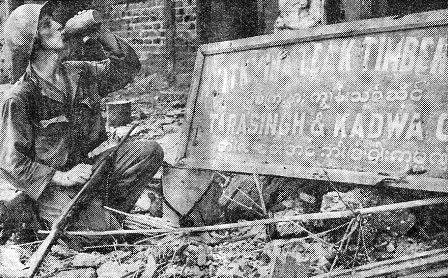
August 1944
Historic Siege of Myitkyina
Beginning 17 May 1944, Chinese and American forces (including "Merrill's Marauders" ) supported by Kachin and other Allied troops laid siege to Japanese-held Myitkyina. It was a critical battle of World War Two, leading to the capture of the all-important Myitkyina airstrip. Myitkyina was captured after only 78 days of savage fighting against an entrenched Japanese garrison.
Altogether nearly 10,000 men were killed or wounded during the historic siege. The Japanese had put up a fierce defence against almost impossible odds, losing over 90 percent of their men. The Japanese commander, Maj-General Genzo Muzikami committed suicide after evacuating the town in early August 1944.
The capture of Myitkyina (and Mogaung around the same time) allowed the Allies to open the new Ledo Road linking India and China. More importantly, control of the Myitkyina airstrip gave the Allies air superiority across the India-China theatre.
On the back of this photograph taken on 1 August 1944 by the US Signal Corps is typed the caption: "Sgt. John Bussites, Mahanoy City [Pennsylvania, USA], takes a break from his duties as liaison sergeant between the Americans and Chinese. He is near the Myitkyina Teak Lumber Company's office in the seventh block of the captured part of Myitkyina. His work carries him up to the farthest forward positions and often exposes him to considerable danger. Because of his baseball ability, the Chinese often call on him to heave grenades when the position is out of their reach."